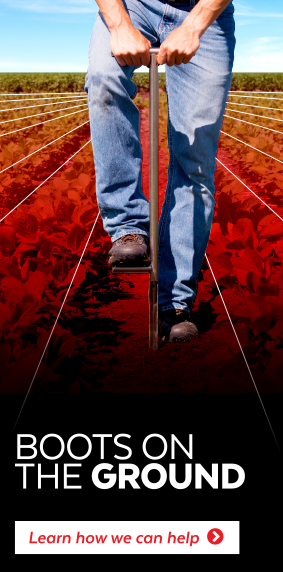We are already halfway through the growing season, and while no single soybean field is going to be at the same developmental stage at the same time, farmers can take steps to ensure that their investment is growing healthy. As the soybeans develop, signs of fungal, viral, or bacterial diseases can make their presence known. Left unchecked and given the right environmental conditions, diseases that attack the soybeans’ stems, leaves, and roots can devastate fields and significantly impact yields. To assist farmers with disease identification, the expert agronomy team at E4 Crop Intelligence has assembled a guide covering signs of a few common soybean diseases that have troubled growers over the past few years.
Septoria Brown Leaf Spot
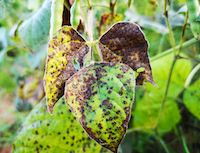
One of the most common and prevalent leaf diseases on soybeans, Septoria brown leaf spot, has been known to show up on leaves from the V2 growth stage to the R6 reproductive stage. While many leaf diseases begin in the upper canopy, brown spot develops below the canopy and works its way up.
Typically, this disease does not cause yield loss. However, given the right environmental and plant conditions, brown spot can lead to defoliation. Factors that create favorable conditions for this disease include high plant density, year-after-year soybean planting, poor tillage, and wet and warm weather. To manage Septoria brown leaf, growers can apply fungicides or rotate crops.
Identifying Symptoms:
- Brown to dark brown spotting on the leaves that are around 1/8th of an inch in diameter in the lower canopy (pictured right)
- A large number of brown spots can combine to create larger blotches
- Yellow- or brown-like patches on a single side of the leaf
Frogeye Leaf Spot
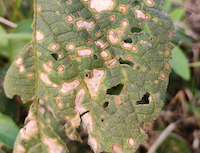
This fungus is a recurring problem in soybean fields across much of North America. Spores from the frogeye leaf spot disease are very resilient and can last over winter by infecting plant residue and seed. During the spring and summer, warmer temperatures and humid conditions stimulate the production and development of this pathogen’s spores.
Identifying Symptoms:
- Leaf spotting where there are brown blotches that are encircled by reddish-brown or purple rings (pictured right)
- The middle of the spots turn tan as time goes on
- Spots begin to merge into a larger cluster and deteriorate to the point where it kills off parts of the leaves
Sudden Death Syndrome
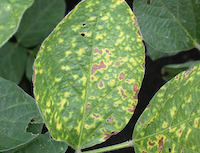
Soybean sudden death syndrome (SDS) is a fungus that infects crops with varying severity. Given the right environmental conditions, SDS can produce a large number of purple-blue colored spores on the root surface that can take hold of nearby soybean plants in patches. The circumstances that favor the disease are cool and wet soil conditions and in fields that have had SDS issues in the past.
Added crop damage can be possible if the field has also had a past problem with soybean cyst nematode (SCN), which also infects the crops’ roots. SDS symptoms are commonly observed around the R3 (pod filling) to R5 (seed development) stages.
While there isn’t a soybean variety with total resistance to SDS, growers can employ different seed treatments that can reduce the disease’s impact. Since wet soil conditions can promote SDS development, producers can take steps to try and minimize soil compaction, improve soil drainage in fields that have a history of SDS.
Identifying Symptoms:
- Patchy brown and yellow discoloration between the leaf veins while the veins remain bright green (pictured right)
- Stem has a light brown color below the epidermis close to the soil line, and the pith remains white
- Leaflets fall while petioles (joining of the leaves and stem) continue to stay attached to the soybean plant
- Root rot (purple lesions on the lower stem) and sometimes blue colored fungal growth on the root
- Symptoms commonly show up in seed fill stages of the soybean plant (R5-R6 stage)
Brown Stem Rot
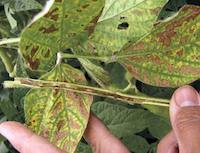
Commonly showing symptoms in mid-August, soybeans infected with brown stem rot (BRS) can be tricky to identify. This disease is dispersed through the soil and thrives in wet, cooler weather in mid-summer. It is a pathogen that can affect the plant in different ways. BRS Type A leads to both leaf and stem degradation, while BRS Type B causes interior stem rot only. Type B is tough to identify because the canopy and stem look healthy while the interior vascular tissue of the stem is deteriorating. Just as with SDS, having a history of SCN can increase the disease’s impact on the plants.
BSR management options available to growers include crop rotation and utilizing resistant soybean varieties. The disease is only known to affect soybeans. By rotating to other crops such as corn, cereal grains, and other forage legumes, a grower can reduce the survivability of BRS in the soil.
Identifying Symptoms:
- Discolored areas of brown and yellow between the leaf veins
- Leaf curling and leaf death
- By splitting the stem, a brown coloring of pith can be seen in the stem (mainly the lower stem)
- Foliar symptoms can be misidentified as SDS
Many of the diseases that plague soybean crops present numerous problems that require long- term decision making and planning for growers. The ag professionals at E4 Crop Intelligence are here to help identify the issues while working with the grower to find a solution that fits their operational needs. For more information on how E4 can provide expertise and guidance in the field, visit www.e4cropintelligence.com.
